Integrating Vue-Based Widgets Directly into Gutenberg: A Deep Dive
Gutenberg, WordPress’s block editor, offers a powerful and flexible system for creating custom content layouts. While WordPress itself utilizes PHP and JavaScript, the ability to integrate modern JavaScript frameworks like Vue.js significantly expands the editor’s capabilities, allowing for more complex and dynamic widgets. This blog post will guide you through the process of seamlessly integrating Vue-based widgets into Gutenberg, providing comprehensive code examples and explanations.
Understanding the Landscape
Before diving into the code, let’s outline the key components involved:
- WordPress: The underlying content management system.
- Gutenberg: The block editor, built using React.
- Vue.js: The progressive JavaScript framework we’ll use for building our widgets.
- Webpack: (or similar bundler) For bundling our Vue components and related assets.
Integrating Vue into Gutenberg requires careful consideration of how these components interact. We’ll leverage WordPress’s block API to register our custom block, and then utilize Vue within the block’s rendering logic. We need to ensure that our Vue components are properly compiled and loaded within the Gutenberg environment.
Setting up the Development Environment
- WordPress Installation: Ensure you have a working WordPress installation (locally or on a server).
- Node.js and npm: Install Node.js and npm (or yarn) on your system. These are crucial for managing our project’s dependencies and build process.
- Project Setup: Create a new directory for your project. Inside, run:
npm init -y
npm install --save-dev @wordpress/scripts webpack webpack-cli vue vue-loader vue-template-compilerThis installs the necessary packages: @wordpress/scripts for WordPress development tools, webpack for bundling, and the Vue.js core packages.
Creating the Vue Component
Let’s create a simple Vue component, MyVueWidget.vue, within a directory named src/components:
<!-- src/components/MyVueWidget.vue -->
<template>
<div>
<h1>Hello from Vue!</h1>
<input type="text" v-model="name" placeholder="Enter your name">
<p>Hello, {{ name }}!</p>
</div>
</template>
<script>
export default {
data() {
return {
name: ''
};
}
};
</script>This component displays a greeting and allows the user to input their name.
Creating the Gutenberg Block
Now, let’s create our Gutenberg block. We’ll place the file src/blocks/my-vue-widget/index.js :
// src/blocks/my-vue-widget/index.js
import { registerBlockType } from '@wordpress/blocks';
import { __ } from '@wordpress/i18n';
import MyVueWidget from '../../components/MyVueWidget.vue'; // Path to your Vue component
// Import the required CSS file
import './style.scss';
import './editor.scss';
// This is where the magic happens: creating a render function for our block using the Vue component.
const render = (props) => {
//Here we will render the Vue component
const { attributes, setAttributes } = props;
//Pass attributes to our Vue component if needed
return <div id="my-vue-widget-root">{/* Vue component will mount here */}</div>;
}
registerBlockType('my-plugin/my-vue-widget', {
title: __('My Vue Widget'),
icon: 'smiley',
category: 'common',
attributes: {
//Add attributes here if your Vue component needs them.
},
edit: render,
save: () => null, // For server-side rendering, this might be different.
});
//We need to mount our Vue component after the editor loads the block.
window.addEventListener('DOMContentLoaded', () => {
const app = new Vue({
el: '#my-vue-widget-root',
render: h => h(MyVueWidget)
})
})Webpack Configuration (webpack.config.js):
const path = require('path');
module.exports = {
entry: {
'my-vue-widget': './src/blocks/my-vue-widget/index.js',
},
output: {
path: path.resolve(__dirname, 'dist'),
filename: '[name].js',
},
module: {
rules: [
{
test: /.vue$/,
loader: 'vue-loader',
},
{
test: /.scss$/,
use: ['style-loader', 'css-loader', 'sass-loader']
},
{
test: /.css$/,
use: ['style-loader', 'css-loader']
}
],
},
resolve: {
alias: {
'vue$': 'vue/dist/vue.esm.js' // required to avoid conflict with other vue versions
},
extensions: ['.js', '.vue']
},
externals: {
jquery: 'jQuery' //Avoid jQuery conflicts.
},
};Adding the Block to your Plugin
You will need a standard WordPress plugin structure. Create a plugin folder, and include webpack.config.js and the src folder inside. Create a my-plugin.php file in the main plugin directory:
<?php
/**
* Plugin Name: My Vue Widget Plugin
* Plugin URI: https://yourwebsite.com/
* Description: A WordPress plugin demonstrating Vue.js integration with Gutenberg.
* Version: 1.0.0
* Author: Your Name
* Author URI: https://yourwebsite.com/
* License: GPL2
* License URI: https://www.gnu.org/licenses/gpl-2.0.html
* Text Domain: my-vue-widget
*/
//This function enqueues your webpack output files
function my_vue_widget_enqueue_scripts() {
wp_enqueue_script(
'my-vue-widget',
plugins_url( 'dist/my-vue-widget.js', __FILE__ ),
array( 'wp-blocks', 'wp-element', 'wp-i18n' ), //Dependencies for gutenberg.
filemtime( plugin_dir_path( __FILE__ ) . 'dist/my-vue-widget.js' ),
true
);
}
add_action( 'enqueue_block_editor_assets', 'my_vue_widget_enqueue_scripts' );
?>
Building and Activating
- Build: Navigate to your project directory in the terminal and run:
npm run build //Assuming you have added a "build" script in your package.json like "build": "webpack"This will create a dist folder containing your bundled my-vue-widget.js file.
- Activate: Activate your newly created WordPress plugin.
Troubleshooting
- Conflicting Libraries: Ensure that you don’t have conflicting versions of Vue or other libraries.
- Webpack Configuration: Double-check your
webpack.config.jsfile to ensure that the paths and loaders are correctly configured. - Plugin Structure: Make sure your plugin is correctly structured according to WordPress standards.
- Browser Console: Inspect the browser’s developer console for any JavaScript errors.
Further Enhancements
- Data Binding: Pass data from Gutenberg attributes to your Vue component for dynamic content.
- Component Communication: Implement communication between your Vue components and Gutenberg’s block editor.
- Advanced Features: Integrate more advanced Vue features such as routing, state management (Vuex), and UI libraries (Vuetify, Element UI).
- Server-Side Rendering (SSR): For optimal performance, consider implementing server-side rendering to pre-render your Vue components.
This comprehensive guide provides a solid foundation for integrating Vue.js components into Gutenberg. By following these steps, you can unlock the power of Vue.js to build rich and interactive widgets within the WordPress block editor, ultimately improving the user experience and expanding the capabilities of your WordPress sites. Remember to always consult the official documentation for WordPress, Gutenberg, and Vue.js for the most up-to-date information and best practices.
